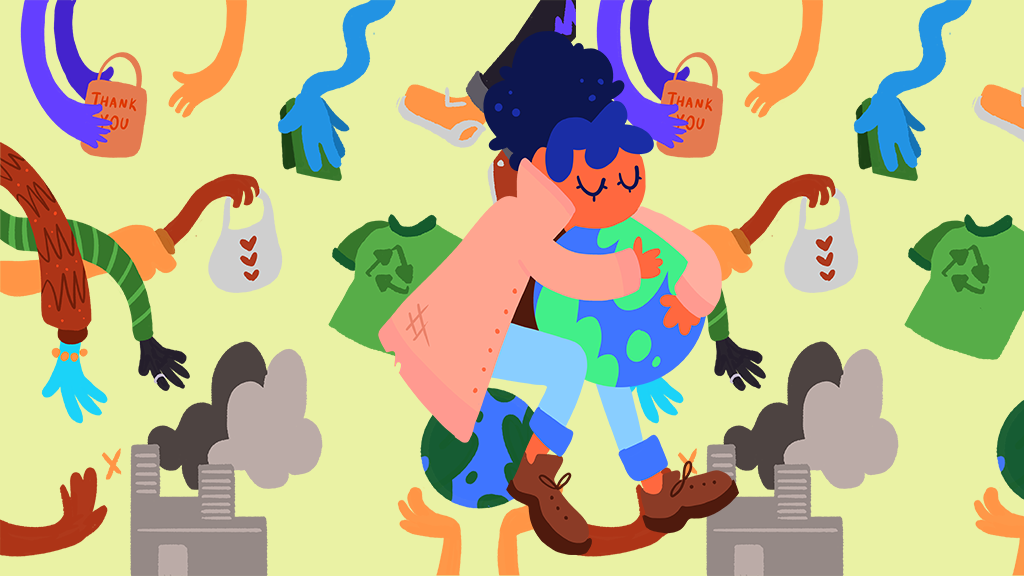Thrift stores bring to mind that all-too-familiar smell of textiles and forgotten memories. The secondhand oversized band tees, out-of-style shoes and strange housewares come together to form a magical place where people can easily lose a few hours. The endless choices can be scary to someone who isn't well-versed in the thrifting scene, which makes going to the thrift store a daunting and often underrated shopping option.
Sari Oister, a third year Photography major, is an avid thrifter with an eye for fashion.
“Thrift stores are like my happy place, I just go in and have no thoughts,” Oister said.
“Thrift stores are like my happy place, I just go in and have no thoughts.”
While some find the variety of choices in a thrift store to be intimidating, Oister sees an endless combination of outfits waiting to be put together.
Combat Consumerism
A main reason why Oister shops exclusively at thrift stores is to help fight the fast fashion industry. Fast fashion refers to the rapidly produced, sold and replaced clothing in chain stores such as Forever 21, H&M and Urban Outfitters.
“Depending on the sources that you are looking at, fast fashion is either the second or third greatest contributor to pollution right now,” Oister said.
Thrifting helps to remove clothes from the waste cycle, reducing the fabrics in landfills that add a large amount of microplastics to water and soil supplies, according to EcoWarrior.
Jaime Huynh, a third year Advertising Photography major, also shops at thrift stores to combat fast fashion.
“One man's trash is another man's treasure,” Huynh said. “So many companies that I used to shop at just pump out millions and millions of garments that don’t even get bought all the time and it just gets trashed.”
“One man's trash is another man's treasure.”
Huynh and Oister are not entirely removed from fast fashion, though. Instead of shopping at chain stores, they go to thrift stores to recreate runway looks and current fashion trends at a reasonable price — all this while helping to reduce textile waste in landfills.
Lauren Avilla, a third year Game Design and Development major, thrifts to not only combat fast fashion but to benefit the environment.
“Denim takes a lot of water [to make] and, being from California, I am very water conscious,” Avilla said. “It is nice to know I am lowering my carbon footprint.”
So, not only are the clothes creating waste themselves, but the process by which textiles are created intensifies the destructive nature of fast fashion.
Fractional Fashion
Thrift stores have a reputation of only having strange shirts, bizarre patterns and outlandish pieces of clothing. While you may get a good laugh trying on these wacky pieces with a group of friends, some of them — when paired with staple wardrobe pieces — can be as fashionable as runway looks.
According to Oister, outfits are about balance. One piece that may be a bit "out there," such as a leopard print jacket or a brightly patterned shirt, can be countered by classic fashion pieces. Thrift stores give clothes that may not be seen as fashionable the chance to be turned into something new. Sometimes it takes a strong sense of self and identity to find these pieces.
“Being comfortable wearing something that may be conventionally ugly and then making it my own is part of the experience,” Oister said.
Huynh, alongside finding fun and flashy pieces to make an outfit pop, keeps tabs on fashion trends. She even has a little notebook where she keeps notes on what is popular.
“I take inspiration from fast fashion pieces and the trends that are coming out, and I apply that when I go sifting through a thrift store,” Huynh said.
Taking ideas from what is in fashion and what you can make fashionable, then using that at the thrift store, allows you to recreate trends for a fraction of the cost.
Secondhand Solutions
A downside to thrift stores is that despite having a variety of clothing to choose from, they typically only have one of each item. So, there are no extra sizes in the back ready and waiting. However, with the right eye and skill set, you can turn an extra-large shirt into a cute summer crop top.
Oister and Huynh share a similar dilemma with clothes shopping — clothes are not always made to fit their body types properly.
“I do a lot of altering after the fact because I have a weird body type to fit clothes to, very straight up and down,” Oister said.
Take time in the dressing room to pinch the clothes to your body and line up seams where they are supposed to rest, and you'll find that a dress or jacket can be given a second life with a little tender love and care. Avilla takes a similar approach when she goes thrifting.
Holding onto her dream of someday owning a sewing machine, Avilla asks herself what she can do to the pieces she finds to make them hers. She weighs whether or not she needs to run her garments through a sewing machine to add a new hem or if she can hand sew the alterations.
The satisfaction of recreating a runway piece from thrifted clothing is something that Huynh, Oister and Avilla all share. With the eye for fashion and the imagination to create a second life for clothes, they are thrifters through and through.
Knowing how to thrift is one thing, but you also have to know where to thrift. They recommend checking out the three big thrift stores in Southtown Plaza — Amvets, Goodwill and Salvation Army.
Whether all, half or just one or two pieces of your wardrobe is thrifted, when you thrift, you are not only saving your wallet — you are also watching out for our planet.








